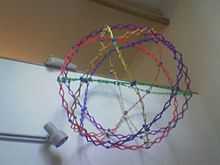Hoberman sphere

A Hoberman sphere is an isokinetic structure patented by Chuck Hoberman that resembles a geodesic dome, but is capable of folding down to a fraction of its normal size by the scissor-like action of its joints. Colorful plastic versions have become popular as children's toys: several toy sizes exist, with the original design capable of expanding from 15 cm (6 inches) in diameter to 76 cm (30 inches).[citation needed]
A Hoberman sphere typically consists of six great circles corresponding to the edges of an icosidodecahedron. The Hoberman sphere can be unfolded by allowing certain members to spread apart. This can be accomplished by feeding out a string or cable in the larger models. The operation of each joint is linked to all the others in a manner conceptually similar to the extension arm on a wall-mounted shaving mirror.
The largest existing Hoberman sphere is in the atrium of Liberty Science Center in Jersey City, New Jersey. Fully expanded, it is 5.5 m (18 feet) in diameter. The motorized sphere weighs 320 kg (700 pounds), is constructed of stainless steel and aluminium, and continually oscillates between its compact and expanded states. The sphere is suspended above the Center's Science Court and is actuated with a computer-based motion control system. This system opens and closes the sphere in a programmed series of lyrical motions choreographed to music, lighting and special effects.[1]